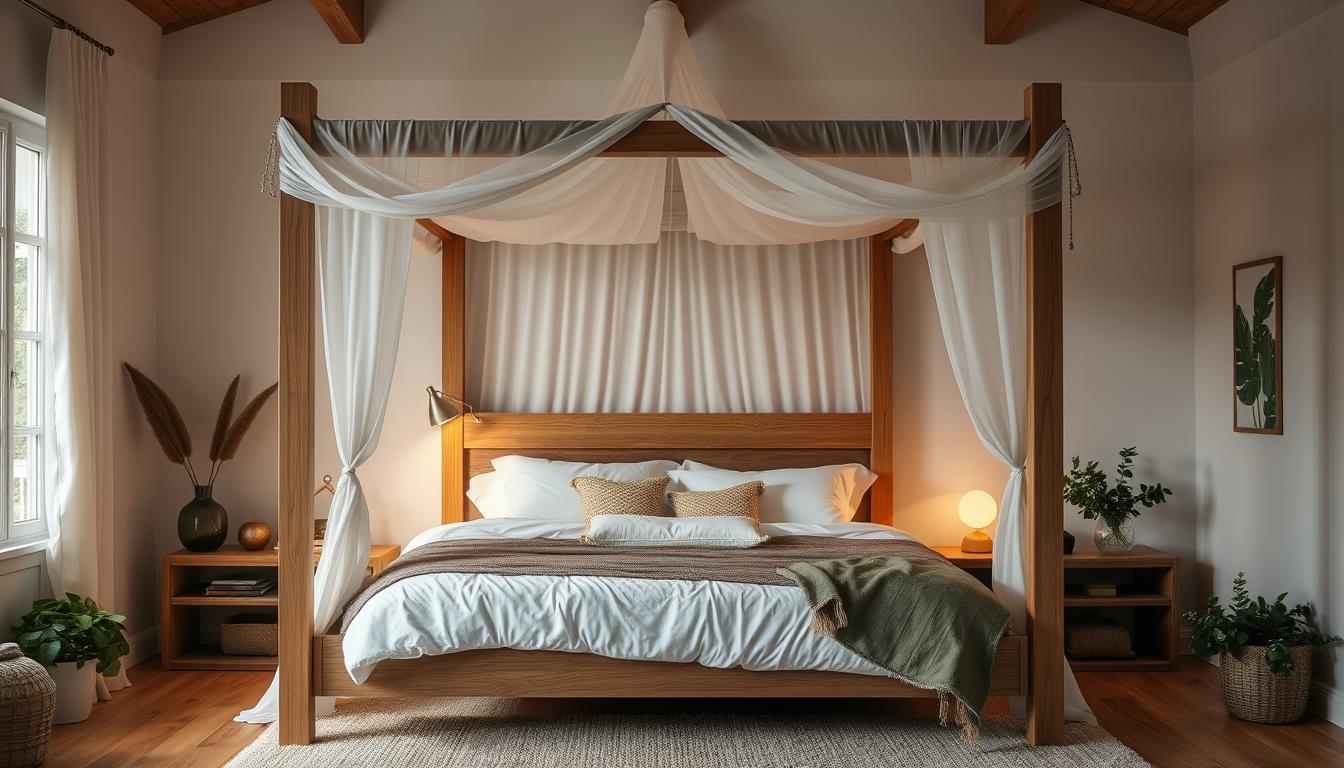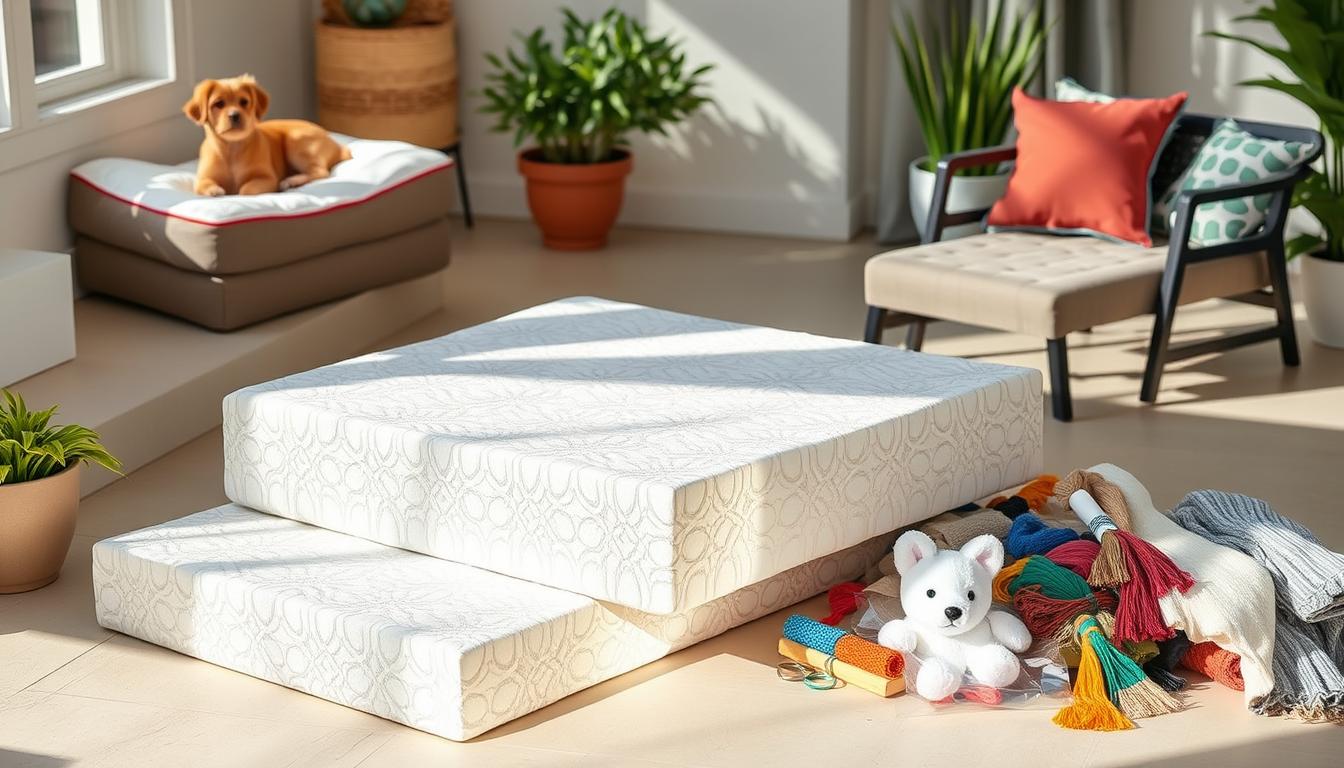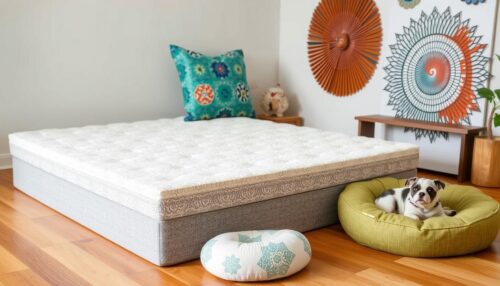Make your sleep better with DIY canopy bed frames! Building your own canopy bed is rewarding and saves money. It adds elegance and luxury to your room. You can choose from classic four-poster or modern ceiling-mounted designs.
Using materials like PVC pipes, wood, or old curtain rods, you can make a bed that shows your style. This guide will show you how to make a DIY canopy bed. We’ll cover the benefits, what you need, and how to do it step by step.
Key Takeaways
- DIY canopy bed frames are cheaper and customizable.
- Building your own bed lets you create a unique space that shows your style.
- You can make many designs, from classic to modern, with the right materials and instructions.
- DIY projects give you a sense of pride and accomplishment.
- Planning and following safety tips are key to a successful and lasting DIY bed.
Introduction to DIY Canopy Bed Frames
Canopy beds make your bedroom look fancy and cozy. You can choose from old-fashioned or modern styles. Making your own canopy bed is fun and lets you make it just right for you.
Why Choose a Canopy Bed?
Canopy beds are loved for many reasons. They make your bedroom feel snug and fancy. Plus, making one yourself can save you money and let you pick the design.
Benefits of Going DIY
- Customizable design to fit your specific needs and preferences
- Significant cost savings compared to store-bought canopy beds
- Opportunity to showcase your DIY skills and create a unique piece of furniture
- Potential for incorporating personal touches and custom features
- Sense of accomplishment and pride in building your own bed frame
With the right stuff and a little effort, you can make your bedroom look great. It’s a fun and money-saving project for anyone who loves making furniture.
Materials Needed for Your Project
Starting a DIY canopy bed frame project means getting the right stuff. You’ll need tools like a miter saw, Kreg Jig, drill, table saw, brad nailer, and sander. These tools help you cut, join, and smooth the wood for a pro finish.
For the wood, pine or common boards in different sizes are good. Hardwood plywood adds durability. For a king-size bed, you’ll need about 22 2x4x8 boards, 4 1x10x8 boards, and 22 1x4x8 boards. You’ll also need pocket hole screws, wood screws, wood glue, and wood filler for your bed woodworking plans.
Essential Tools for Building
- Miter Saw
- Kreg Jig
- Drill
- Table Saw
- Brad Nailer
- Sander
Suggested Wood Types for Frames
- Pine
- Common Boards
- Hardwood Plywood
Looking to save money? Try using PVC pipes for your DIY bedroom decor project. With the right tools and materials, you can make a beautiful canopy bed frame that matches your style and space.
Design Options for Canopy Beds
DIY canopy beds offer endless design choices. You can pick from classic four-poster frames to sleek, modern styles. The right bed can make your bedroom look and feel amazing. Whether you like fancy headboards or simple four-poster designs, knowing your options helps you pick the best one.
Traditional vs. Modern Styles
Traditional canopy beds are all about grandeur. They have fancy headboards, big curtains, and a strong look. On the other hand, modern beds are sleek and simple. They use clean lines and light materials for a fresh, modern feel.
How to Choose Your Design
- Think about your room’s size. Big rooms can handle bold, dramatic beds. Smaller rooms do better with simpler designs.
- Look at your room’s decor and what you like. Classic beds fit elegant rooms, while modern ones suit modern or industrial styles.
- Choose how much you want to see. A full canopy wraps you in comfort. A partial one or bed crown adds a touch without being too much.
The best canopy bed design is one that matches your taste and room. With so many choices, you’ll find the perfect fit for your space and style.
Step-by-Step Guide to Building a Canopy Bed
Making your own canopy bed is rewarding and saves money. First, set up your workspace and get all the materials. Here are the main steps to build the bed frame and add the canopy.
Preparing Your Workspace
Find a big area with lots of light and easy tool access. Put out all the lumber, hardware, and supplies before starting. Make sure you have a strong work surface, like a workbench or big table, to put things together.
Constructing the Frame
Begin by cutting lumber for the legs, rails, and headboard/footboard. Use a miter saw or table saw for accurate cuts. Drill holes for screws and start with the side assemblies.
Then, add the mattress slats and build the headboard and footboard. Lastly, connect everything to make the full bed frame.
Adding the Canopy
To add the canopy, install ceiling brackets or use adhesive hooks for a temporary fix. Measure your bed well to fit the canopy fabric right. Hang the curtains or fabric and adjust them to get the look you want.
Following these steps will help you make a beautiful DIY canopy bed. Always work safely, measure carefully, and take your time. This way, you’ll create a sturdy and nice-looking piece of furniture for your bedroom.
Finishing Touches
As you near the end of your DIY canopy bed project, focus on the finishing touches. Sanding, painting, and picking the right fabrics for your canopy are key. These steps will make your bedroom look great and your bed look professional.
Sanding and Painting Your Bed
First, sand the canopy bed frame well. Use a random orbital sander or a handheld belt sander for a smooth finish. Always sand with the wood grain for the best results.
After sanding, clean off dust and prime the frame. Then, pick your paint or stain color and apply it evenly. For a pro look, use a spray paint or stain applicator. Let it dry fully before moving on.
Choosing the Right Fabrics
- For a light, romantic feel, choose lightweight fabrics like voile or chiffon for your canopy bed.
- For more privacy and light blocking, go for heavier materials like velvet, satin, or blackout curtains.
- Use curtain tape or rings and hooks to make attaching and hanging fabric easy.
The fabrics you pick should match your DIY bedroom decor. They should help create the perfect mood for your canopy bed.
Safety Tips for DIY Projects
When you start a DIY canopy bed frame project, safety is key. Use the right tools and follow the best methods. This way, your bed will be strong and last long, avoiding common mistakes.
Ensuring Stability and Strength
For a solid bed woodworking plans, use strong screws and good joints. Get a reliable drill and top-notch screws for the canopy’s weight. If it’s ceiling-mounted, check the hardware’s weight limit and use the right anchors.
Avoiding Common Mistakes
- Double-check your measurements to fit your mattress right.
- Add support like cross-bracing to keep the frame stable.
- Work safely on ladders with spotters and wear sturdy shoes.
Focus on safety and follow the best methods. You’ll make a beautiful, useful, and lasting canopy bed for your room.
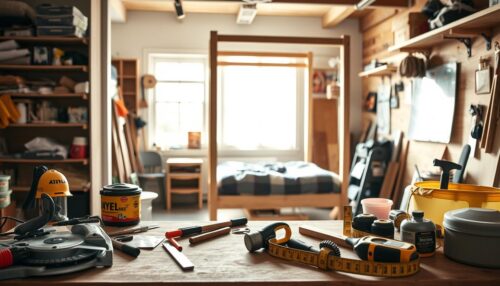
Customizing Your Canopy Bed
Make your bedroom special with a unique canopy bed. Choose your own fabrics and add storage. Turn your bedroom into a cozy retreat.
Ideas for Unique Canopy Designs
Try out different canopy styles for a unique look. Go for a soft fabric canopy for romance or a rigid one for modern style. Add asymmetry for a bold look.
Decorate your canopy with trim, tassels, or lights. Make it truly yours.
Incorporating Storage Solutions
Add smart storage to your canopy bed. Use under-bed drawers for clothes or linens. Add shelves to the headboard for books or decor.
Customizing your canopy bed is fun. Get creative with fabrics, decor, and storage. With DIY, you can make a beautiful and useful canopy bed. It will make your bedroom makeover ideas and custom bed frames stand out.
Budgeting for Your DIY Canopy Bed
Building a beautiful canopy bed doesn’t have to cost a lot. You can make one yourself for much less than buying one. With some planning and creativity, you can make a DIY canopy bed that’s both affordable and stylish.
Estimated Costs Breakdown
Building a DIY canopy bed frame can cost about $375. This includes the wood, hardware, and other supplies. In contrast, a ready-made canopy bed can cost over $1,000.
Tips to Save Money
- Think about using materials like PVC pipes or old furniture to save money.
- Use old sheets, curtains, or other fabrics to make the canopy instead of buying new ones.
- Look for sales, discounts, and coupons on materials to cut costs.
- Choose cheaper options like pine wood instead of hardwoods.
- Do the work yourself to save on hiring a professional.
With a bit of creativity, you can make a stunning affordable DIY furniture piece. Focus on saving money to enjoy a beautifully made canopy bed without spending too much.
Maintaining Your Canopy Bed
Having a beautiful canopy bed is a dream for many. But, keeping it in top shape needs some care. Regular canopy bed care and furniture maintenance are key to making it last.
Cleaning Tips for Longevity
Dust the wooden or metal frame of your canopy bed often. Use a soft cloth and mild polish to clean it. For the canopy fabric, follow the care instructions from the maker.
Gently wash the fabric by hand or in a machine, as suggested. Make sure it dries completely before putting it back.
When to Make Repairs
Check your canopy bed for loose screws or wobbles. Tighten any loose parts to keep the frame strong. If you hear creaks or unusual sounds, fix them right away to avoid damage.
For big repairs like broken posts or torn fabric, get a professional. Following these furniture maintenance tips will keep your canopy bed in great shape. With the right care, your DIY canopy bed will be a bedroom highlight for years.
Inspiring DIY Canopy Bed Ideas
Building a DIY canopy bed can add elegance to your bedroom. You can choose from simple designs to ones with lots of details. Let’s look at some ideas to get you started.
Minimalist Canopy Beds
A minimalist canopy bed is perfect for a modern look. It has a simple wooden frame and white fabric panels. This design creates a calm, clean space.
Luxury Canopy Inspirations
For something fancy, go for a luxury canopy bed. These beds have fancy woodwork, metal details, or rich fabrics. Think of a bed with a big, flowing canopy or one with lace and velvet.
DIY canopy beds let you express your style. You can use old doors or branches for a unique look. Try different fabrics, lights, and decorations to make it yours.
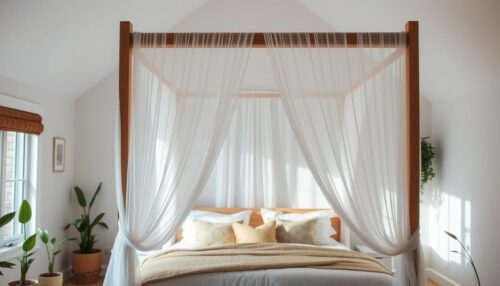
With creativity and the right tools, you can make your bedroom special. Whether you like simple or fancy designs, making your own canopy bed is rewarding and inspiring.
Troubleshooting Common Issues
Building a DIY canopy bed is rewarding, but you might face some problems. Don’t worry, you can solve these issues easily. This way, you’ll enjoy your canopy bed for many years.
How to Fix Wobbly Frames
If your canopy bed frame wobbles, there are easy fixes. First, check if all joints are tight. Use a wrench or screwdriver to tighten loose screws or bolts. If it’s not fixed, add support brackets to make it stable.
Dealing with Fabric Hang-ups
Keeping your canopy fabric looking good can be hard. Make sure the fabric is tight when you first put it up. Use weights or tie-backs to keep it in place. If it sags, adjust the mounting points or add more support.
With patience and the right methods, you can fix any canopy bed maintenance issues. Fix problems early to avoid bigger problems. By doing this, your canopy bed will stay cozy and useful for years.
Conclusion and Encouragement
Building a DIY canopy bed frame is a fun project. It makes your bedroom look great and saves money. You can make a space that shows off your style and makes your bedroom feel special.
Celebrate Your DIY Success
Be proud of what you’ve made. You can choose from many designs, like a simple metal frame or a fancy draped canopy. It shows your creativity and DIY skills.
Enjoy the feeling of making your room cozy and inviting. It’s a special place just for you.
Sharing Your Creation with Others
Share your DIY bed project on social media. Use hashtags like #DIYCanopyBed or #BedroomMakeover. This might inspire others to try DIY projects too.
It helps build a community of people who love DIY and making their homes special.

